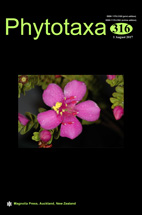Abstract
Piper magen (Piperaceae) sp. nov. from Yunnan Province, China, is here described and illustrated. This species is similar to P. nudibaccatum, but the former can be distinguished by the following combination of characteristics: woody climbers with well-developed longitudinal ridges, these with obtuse, corky wings; leaves dimorph, mature leaves green at adult stage, elliptic or ovate with oblique leaf base, veins 7–9, pinnate, but leaves cordate, heterochromous at juvenile stage, with veins zone greyish white on the adaxial surface, veins 5–7, palmate; male spikes with sterile apical region ca. 1–3 mm long, glabrous, pale green; stamens 3; filaments very short and flat (with stereoscope); bracts suborbicular with dense, brownish red dots visible on adaxial surface, with dense cilium on abaxial surfaces (with stereoscope); stigmas 3 or 4, linear, reflexed, sparsely velutinous.

